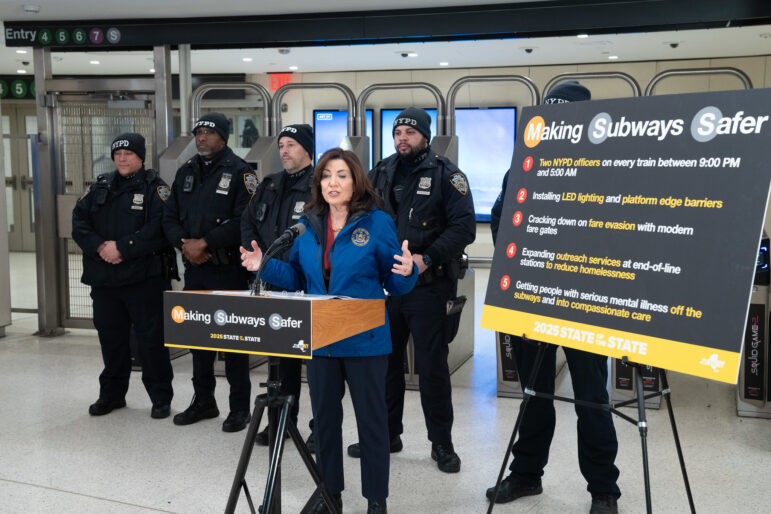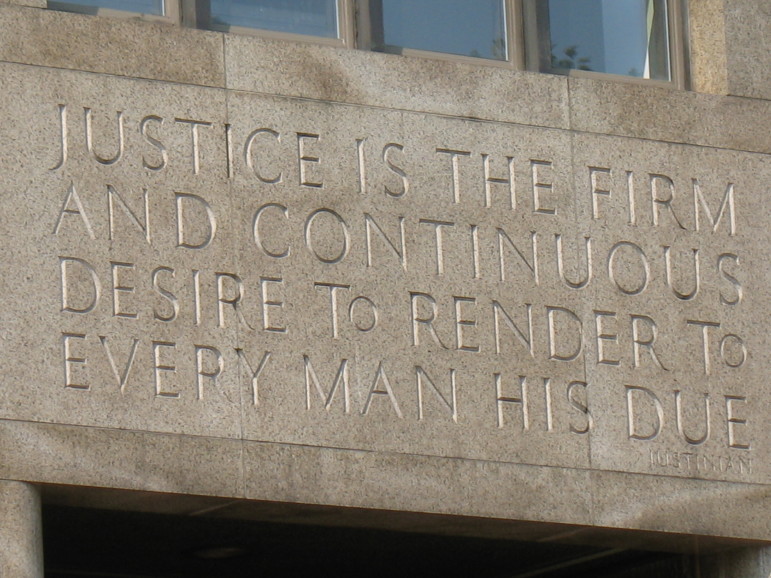The graph from the Human Resources Administration is as remarkable as it is unmistakable: The number of New Yorkers receiving welfare, after peaking in 1995 at more than 1.1 million, plunged steadily to 343,000 at the end of 2008 – the lowest number in 45 years.
It’s a drop that the Bloomberg Administration has cited as a mark of the city’s success at moving people off the welfare rolls, mostly via “work first” policies geared toward getting individuals into paid employment. But as in other states, the falling caseload numbers come at a time of rising unemployment, record homelessness, and after years of soaring patronage of soup kitchens and food pantries. It’s a contrast that puzzles many longtime observers of welfare policy, leading them to wonder whether local government is doing enough to respond to the economic crisis – and when the other shoe is going to drop.
It’s certainly reason for concern, argues policy director Bich Ha Pham of the Federation of Protestant Welfare Agencies, which is preparing a study on welfare reform implementation in New York for release next month. During economic downturns in the early ’80s and especially the early ’90s, city records show, the welfare caseload jumped dramatically. By contrast, during the post-9/11 recession in 2001 and 2002, notes Pham, levels of welfare receipt rose only slightly, then immediately began their downward trend. (In New York, “welfare” incorporates both the federal Temporary Assistance to Needy Families program, and the state Safety Net program for unmarried individuals and those who’ve exhausted their federal benefits.) And as the current downturn escalated, there’s been no corresponding rise in those getting public cash assistance. “In the first half of 2008, the number of New Yorkers without jobs increased by 56,000, yet the welfare caseload dropped by over 10,000,” says Pham.
One explanation, say welfare experts, is that there’s typically a lag time between an economic downturn and more people applying for welfare, in part because newly laid-off workers typically access other benefits like unemployment insurance – or look for lower-wage jobs – before resorting to welfare.
“We are in some respects the end of the line,” said HRA commissioner Robert Doar, who projects only a “slight increase” in welfare caseload in 2009. There are many other public benefits that people short on income can apply for, Doar noted in a recent interview, pointing out that both food stamps and public health care have seen increased enrollment.
David Hansell, the former HRA chief of staff who in 2007 took over for Doar at the state Office of Temporary and Disability Assistance, agrees that it will likely take time before the effects of the economy are seen in the welfare numbers. But, he says, that time may already be at hand: “In the last quarter of 2008, [the state] actually saw the first quarterly increase we’ve seen in many years – up about 2.7 percent.” That may presage a continued rise in the rolls, he says: “We may have begun to see the point where we’ve bottomed out.”
Back to work?
If so, the next question is what to do about it. The long decline in the welfare rolls has gone hand-in-hand with the introduction of a “work first” model, which most recently has included “work supports” like the earned income tax credit and an expanded child care tax credit to make it easier for the working poor to get by. “Our view is that the best way out of difficult times is employment, even low-wage employment,” says Doar, “and then taking advantage of our various work support programs like food stamps, Medicaid, earned income tax credit, other ways of grossing up the wages that they earn.”
To use work supports, though, one still needs work, which may be harder to come by as the recession worsens. Doar insists that hasn’t yet become an issue, and that HRA actually placed more people in jobs in 2008 than in 2007. “Entry-level positions are still hiring,” he says, citing the retail and service sectors as examples. “People are often trading up, or doing that for a while and then the next thing. And when that happens, those jobs open up.”
But Omari Gay, director of workforce development for the low-income housing nonprofit Phipps Houses, tells a different story. “Without question” the economic downturn is affecting both the number of people applying for work and the ability to place them into jobs, says Gay. In 2007, he says, his program saw a total of 209 participants in Back to Work, the city program instituted the previous year in which anyone applying for welfare is placed into job search and workfare even before their benefits are approved. “We placed into employment 93 of them. Last year we saw over three times that amount, and placed around the exact same number. No question, it was a scary feeling.”
Gay says he believes there were “many more applicants” for welfare benefits last year, adding that “because of the stagnant job market, there were more people staying on welfare for a longer period of time, because they couldn’t find the work.” The question then becomes: If more people are applying, why aren’t more people receiving benefits?
One concern, says Brenda Beal, a welfare recipient herself and member of the low-income advocacy group Community Voices Heard, is that applicants may be getting diverted before they can begin receiving benefits. Under Rudolph Giuliani, HRA began making “diversion” a stated goal, and the Bloomberg administration has been criticized by some for continuing to impose barriers for those seeking public assistance. “When people are applying for public assistance, there’s a 30- to 45-day wait to get a case opened,” notes Beal. “And some people get sanctioned before their case is opened” – losing their benefits before they’ve even begun.
A Community Voices Heard report last fall charged that, thanks to pre-benefits sanctions and other diversion tactics, only 8 percent of those entering Back to Work actually made it into paid employment – and that fully four in five people applying for welfare dropped out before entering Back to Work’s 35-hours-a-week program of unpaid workfare and job training.
HRA spokeswoman Barbara Brancaccio disputes these figures, saying the agency’s own records show that over the first two and a half years of Back to Work, only 30 percent of those referred to the program dropped out before enrolling, and just over 15 percent were placed in paid employment. But HRA can’t shed any light on whether welfare applications are rising even amidst falling caseloads: The agency doesn’t track how many people apply for public assistance, according to Brancaccio, only how many ultimately receive it.
And back to school
State welfare chief Hansell, meanwhile, is concerned that rather than the unemployed taking on low-wage jobs as other workers trade up, the opposite may be taking place. In hard times, “jobs cascade downwards,” he says. “As people that are being displaced from higher-level jobs start moving down the ladder, the people most likely to be displaced are the people at the bottom of the ladder who have the weakest skills.” Gay says this is already starting to show up in the home health care field, which used to have high turnover, but “not any longer – people are just holding onto what they can.”
In response, Hansell says the state is moving ahead with plans to move more welfare participants into education and training: a new Career Pathways program, enhanced use of employment and training funding provided under the federal food stamp program, and new regulations requiring that county social service districts do educational assessments of applicants for public assistance. With Washington having recently eased federal welfare requirements to allow more education and training options to count as required “work activities,” Hansell says these new initiatives are geared to allow people greater options, “so that if there aren’t immediate employment prospects for them, we continue to focus on increasing their skills, so that when the job market turns around, they’ll be able to compete for the jobs that exist.”
Educational options for those receiving welfare could expand even more under a bill introduced by Manhattan Assemblyman Keith Wright last month, which would allow time spent at four-year colleges to count as a welfare work activity – something newly allowable under federal law, but barred by state law. Dillonna Lewis, co-director of the Welfare Rights Initiative at Hunter College, which is helping marshal support for Wright’s bill, calls it “a win-win situation for students and the local districts,” since it would both allow students to pursue a bachelor’s degree without being forced to juggle schoolwork and workfare, while also making it easier for counties to meet the new requirement that 50% of the welfare caseload be engaged in allowable work activities.
Gay, meanwhile, says his organization is turning its attention to programs like skills training and financial literacy sessions, to help people manage until, hopefully, the economy begins to turn around. “We’re trying to use this time to prepare them,” he says, “for once they come out of the situation.”








